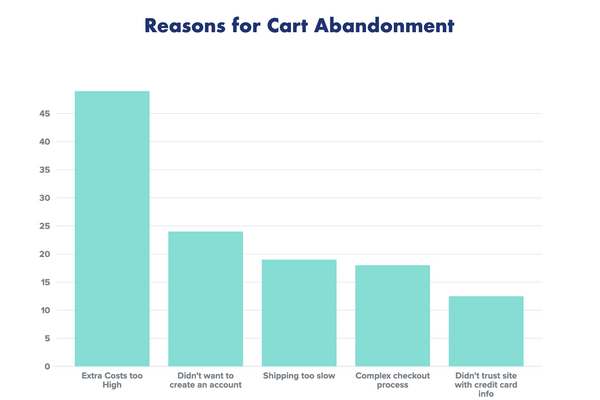No matter your industry, no matter the size of your business, there’s one issue that always comes up - cart abandonment. It’s something that we’re all guilty of; finding a new site, adding something to your cart, then leaving the site without checking out. Maybe you’re just looking into something, or maybe you added it with the intention of buying later. Whatever the reason, cart abandonment is extremely common in ecommerce with on average 69.8% of carts being abandoned. That means over two thirds of potential customers aren’t converting, and that will undoubtedly set off alarm bells for any merchant.
Once a customer abandons a cart, they’ll soon after encounter something else we’re all familiar with - Abandoned Cart emails. These emails are a vital part of any ecommerce merchant’s toolkit, but many will just set up a flow and let it run its course hoping for the best. However if they really want to make the most of their Abandoned Cart emails and drive conversions, they need to have a solid strategy that puts testing, tailoring, and understanding at the forefront.
Why Abandoned Cart emails are important
Given the high average rate for cart abandonment, it can feel a bit like a lost cause in trying to convince customers to come back and complete their purchase. After all, they’ve already seemingly decided against it at the last second. However the benefits in pursuing those abandoned carts are massive - just among Klaviyo customers, Abandoned Cart emails had an average open rate of 41.18%. Moreover the conversion rate for Abandoned Cart flows is 3x higher than any other automated flow.
Abandoned Cart flows also present a unique opportunity to win back casual browsers that could become loyal customers. Whether they’re a new customer or have made a purchase previously, if they’ve abandoned a cart you already know they’re interested in your brand and products. You’ve got data about them that you can use to tailor content, and demonstrate your brand’s unique selling proposition over your competitors through your abandoned cart emails while also reminding them of the products they want. These automated flows then become a valuable part in building strong relationships with your customers; for new customers, it’s their first positive direct interaction with your brand, and for returning customers they’re reminded of why they enjoyed their experience previously.
1 - Understand why Abandoned Carts happen
Everything about your ecommerce store relies on understanding your customers. In developing a new product, you look to understand how it will appeal to your customers. When you’re planning for social media, you want to create content that your customers will respond to and be engaged with. The same goes for your email marketing, and especially your Abandoned Cart flow. We know that most carts are abandoned, but understanding the reasons why people aren’t completing checkout will help you to create emails that can address some of those issues.
According to data from the Baymard Institute about consumer behaviour and abandoned carts, 58.6% of consumers said that they did so because they were “just browsing” or “not ready to buy”. Once you remove those responses, the distribution of the next top five reasons looks like this:

- 49% say that extra costs are too high e.g. shipping, additional fees.
- 24% cited being forced to create an account put them off
- 19% said that the shipping options were too slow
- 18% were put off by the length or complexity of the checkout process
- 17% didn’t trust the site with their credit card information.
Of course there are some you can’t address in an Abandoned Cart email, so these can be issues you can reflect on for the rest of your store. The primary reason however for cart abandonment is definitely an issue which you can address - “just browsing” and “not ready to buy”. These customers are interested but they’re still in that research phase of the customer life cycle. To boost their chances of making a purchase, they’ll want more information and incentives as a minimum. Understanding that this is the primary reason why customers aren’t checking out means that you can build a really solid strategy with the content of your Abandoned Cart emails.
2 - Personalize emails to catch attention
As with every other part of the customer experience, personalization is an important factor in your Abandoned Cart emails. 80% of customers say that they’re more likely to make a purchase from a brand that personalizes the experience, and you can re-capture potential customers by giving them a taste of your store’s personalized experience in your abandoned cart emails. How do you do this? Using your store’s data.
Your store gathers an invaluable amount of behavioural data that you can use to your advantage in re-engaging a potential customer. From what products they browsed to whether or not they’ve made a purchase before and what that purchase was. Therefore you can personalize content in abandoned cart emails to show more information or complementary products to the ones currently in their cart. Or perhaps complementary products to what they’ve purchased previously. Another easy way to add a more personal touch to these emails is to personalize subject lines and content in the email itself if you have the customer’s name - personalized subject lines on average see a 50% higher open rate.
A standard series of a few abandoned cart emails that all say the same thing are unlikely to catch the eye of an unconvinced customer, but showing that you want to personalize and cater to each individual customer is something that will grab their attention.
3 - Find what works best for your audience with A/B testing
Testing, tweaking, and re-testing should be an integral part of any Abandoned Cart email strategy. Making use of A/B testing in Klaviyo will allow you to see exactly what does and doesn’t work for your individual audiences to ensure you’re always putting out the most effective messaging for your Abandoned Cart flow. Elements you can test include:
-
Subject lines - You can try adding more urgent messaging to a subject line versus a less urgent one, to see if urgency is something your customers respond to. Or you can test other elements such as adding emojis, or personalization.
-
Timing - Knowing when to send an abandoned cart email is a big step in your strategy. Use A/B testing to try out different send times, for example sending your first email 1 hour after abandonment versus 6 hours.
-
Content - The content of an email matters, and you can test to see if your customers respond better to more or less content in an email. You can also try more imagery versus more text, whether social proof or educational content is more convincing etc.
-
Calls-to-Action - Testing different styles, wording, and placement of your CTA in an Abandoned Cart email is important for finding which combination is the most effective for different audience segments.
- Incentives - If you want to know which type of incentive to use, then A/B testing can help you find an answer. Especially if you want to test this in different audience segments for example if new customers respond better to free shipping or a flat discount.
Different types of test will influence different elements such as open rate, click through rate, and conversions, so it’s worth keeping an eye on these to see which set in your tests performs best in each metric. For example if you find that one set has higher conversions but a lower open rate whereas another set has a higher open rate and lower conversions, see if you can tweak elements in each to find that sweet spot where both are increased.
4 - Utilize branching to tailor messaging
If you want to add even more complexity to your Abandoned Card flows, then branching is the solution. Branching in Klaviyo is where you can automatically send different messaging for the same flow depending on if a subscriber matches a certain set of criteria. For example it’s generally considered best practice to send different messaging to someone who has previously made a purchase, versus someone who hasn’t yet made a purchase. This not only adds further personalization, but also allows you to tailor exactly what your abandoned cart strategy is depending on the circumstances of the customer in question especially if you’re planning on offering an incentive. You can then offer different incentives for different customer segments. Some examples include:
-
First-time purchase vs existing customer
If you want to offer a 10% off your first purchase, then you won’t want to send this to your existing customers as it won’t be of use. You can also include more brand information for new customers, or product recommendations based on past purchase to existing customers.
-
Cart Value
For larger orders, you might want to offer an incentive earlier or of a higher value to those that have a smaller order. Or perhaps you want to add more recommendations of complementary products to not only engage a lower value order, but to encourage them to add more to their cart.
-
Domestic customers vs international
If one of your incentives involves free shipping, then this might not necessarily be viable if that customer is international. The information they might find useful will also be different around shipping and returns, and recommendations might be different due to restrictions. If you want even more info about international email, we’ve written another in-depth article about this topic.
5 - Use other channels to boost strategy
You don’t need to stop with emails, your Abandoned Cart strategy should include other channels as part of your effort to re-engage potential customers. By making use of other owned marketing channels such as SMS alongside your email flow, you can develop a robust Abandoned Cart strategy that speaks to your customers even if your initial emails get lost in their inbox.
You can use Klaviyo’s SMS features to complement and boost your Abandoned Cart flow for customers based in the US. If you have double opt-in as well as permission to use SMS, you can incorporate it into your flow to target those subscribers who haven’t yet opened emails. Once they’ve received the initial text message, you can then set it up so that they rejoin the flow and don’t miss any other emails about their cart. Plus as a Shopify merchant, you’ll be able to use dynamic cart links so they can go straight back to their cart from the text message itself.
---
Abandoned cart emails are your opportunity to show undecided customers what they’re missing out on and re-engage them. By making use of all the tools available such as A/B testing and personalization, merchants can develop a robust abandoned cart strategy that drives more conversions and genuinely interests potential customers.

